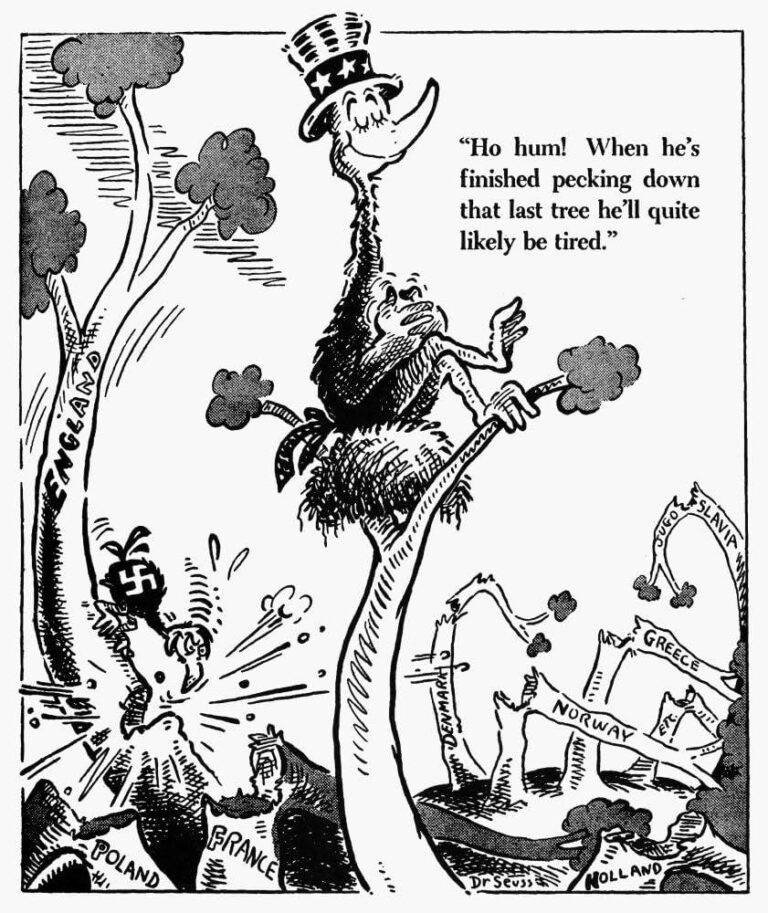Dr. Seuss is a name synonymous with whimsical rhymes and beloved children’s stories, but few are aware of his potent work as a political cartoonist. Long before his iconic books captured the imaginations of young readers, Theodor Seuss Geisel wielded his pen to challenge social injustices and global conflicts with sharp wit and bold imagery. Upworthy takes a closer look at this lesser-known side of Dr. Seuss, revealing how his political cartoons were not only groundbreaking for their time but remain strikingly relevant today.
Dr Seuss Beyond the Rhymes Exploring His Impactful Political Cartoons
Long before becoming a household name through whimsical tales and imaginative characters, Dr. Seuss, born Theodor Seuss Geisel, wielded his pen with sharp political insight. His cartoons, published in prominent newspapers during World War II and the post-war era, tackled complex themes such as fascism, racism, and isolationism with a biting wit and clear moral compass. Unlike his children’s books that convey lessons through playful rhymes and nonsense words, these cartoons served as urgent calls to action, reflecting the turbulence and anxieties of his time.
His political cartoons often featured:
- Bold visual symbolism to expose social injustices and ideological threats
- Satirical caricatures of world leaders and policies, dissecting their motives
- A plea for unity and justice, underlying his belief in the power of individuals and communities to resist oppression
Through this work, Dr. Seuss’s influence extended far beyond children’s literature, positioning him as a potent voice in American political discourse. His legacy in editorial art reveals the multidimensionality of his creative genius, reminding us that beneath the playful whimsy was a deeply engaged commentator on society’s gravest concerns.
Analyzing the Themes and Messages in Dr Seuss’s Editorial Art
Beneath the whimsical whimsy of Dr. Seuss’s editorial cartoons lies a potent critique of societal and political issues that were as relevant then as they are today. His art cleverly used satire to dissect themes such as war and peace, racial injustice, authoritarianism, and the folly of prejudice. Not simply caricatures, these illustrations served as visual editorials, urging audiences to reflect on the consequences of hatred and the value of unity. By juxtaposing playful characters with serious political commentary, Dr. Seuss challenged the status quo, demonstrating that art can educate and provoke change simultaneously.
Much of his editorial work revolved around championing human rights and questioning government policies. Key messages can be identified through recurring elements such as:
- Opposition to fascism: Portrayals warning against the dangers of totalitarian regimes.
- Anti-discrimination stance: Cartoons advocating racial equality and celebrating diversity.
- Critique of isolationism and complacency: Illustrations emphasizing the need for active civic engagement.
These themes are not only historically significant but echo through the decades, reminding readers that the fight for justice and dignity transcends time. The intricate layering of humor, symbolism, and critique in Dr. Seuss‚Äôs editorial art enriches our understanding of his legacy beyond children’s literature.
| Theme | Message | Visual Symbol |
|---|---|---|
| Anti-Fascism | Warning against tyranny | Menacing snakes |
| Racial Equality | Celebrating diversity | Interlocking hands of various colors |
| Civic Responsibility | Engagement over apathy | People voting |
How Dr Seuss’s Political Cartoons Shaped Public Opinion During World War II
During World War II, Theodor Seuss Geisel, widely known as Dr. Seuss, harnessed the power of his pen to influence public opinion through sharp and provocative political cartoons. Published primarily in The New York newspaper PM, these cartoons tackled subjects ranging from isolationism and fascism to racial prejudice and the war effort itself. Utilizing bold, exaggerated caricatures, Dr. Seuss effectively conveyed complex political messages that challenged complacency and stirred readers to question the status quo. His work not only rallied support for America’s involvement in the war but also exposed the stark consequences of passive indifference.
What set these cartoons apart was their ability to connect emotionally while delivering a clear call to action. His visuals encapsulated critical attitudes of the era, highlighting:
- The dangers of appeasement: Warning against the consequences of ignoring Nazi Germany’s aggression.
- Condemnation of racism and anti-Semitism: Advocating for equality as a moral imperative amidst global conflict.
- Support for military preparedness: Urging citizens and policymakers to stand united in defense of democracy.
| Cartoon Theme | Impact on Public | Publication Year |
|---|---|---|
| Anti-Isolationism | Raised awareness about global threats | 1941 |
| Anti-Fascism | Mobilized public support for war efforts | 1942 |
| Racial Equality | Challenged discriminatory attitudes | 1943 |
Lessons from Dr Seuss’s Cartoons Applying Political Satire in Modern Media
Dr. Seuss’s cartoons expertly blend whimsy with sharp critique, proving that humor can be a powerful vehicle for social commentary. His use of exaggerated characters and absurd scenarios brought clarity to complex political issues, making them accessible to a wide audience. Modern media can take a page from his playbook by incorporating vivid imagery and symbolic caricatures that distill multifaceted debates into digestible, compelling narratives. This approach not only engages viewers but encourages a deeper reflection on the topics at hand.
Additionally, his work demonstrates the importance of timeliness and boldness in political satire. Dr. Seuss didn‚Äôt shy away from addressing controversial subjects head-on, using satire as a catalyst for public discourse. For today’s content creators, this means embracing relevant issues and delivering critiques with clarity and courage. Here are key takeaways for integrating these lessons in modern platforms:
- Use relatable symbolism: Simplify complex ideas with memorable symbols.
- Balance humor and message: Ensure satire entertains but also enlightens.
- Connect with current events: Timeliness amplifies impact.
- Engage diverse audiences: Make satire inclusive to resonate broadly.
| Element | Dr. Seuss’s Approach | Modern Media Application |
|---|---|---|
| Imagery | Whimsical, exaggerated characters | Dynamic visuals and memes |
| Message | Bold political critique | Clear, timely narratives |
| Audience | General public, all ages | Targeted diverse demographics |
| Tone | Humorous yet serious | Balanced satire and earnestness |
Wrapping Up
In exploring the lesser-known political cartoons of Dr. Seuss, it becomes clear that his creative impact extended far beyond the whimsical world of children’s literature. These incisive and thought-provoking illustrations reveal a sharp social conscience and a fearless engagement with the pressing issues of his time. As we reconsider Dr. Seuss‚Äôs legacy, it is important to acknowledge the depth and breadth of his work‚ÄĒreminding us that even beloved cultural icons can wield their talents in the service of profound political commentary.







